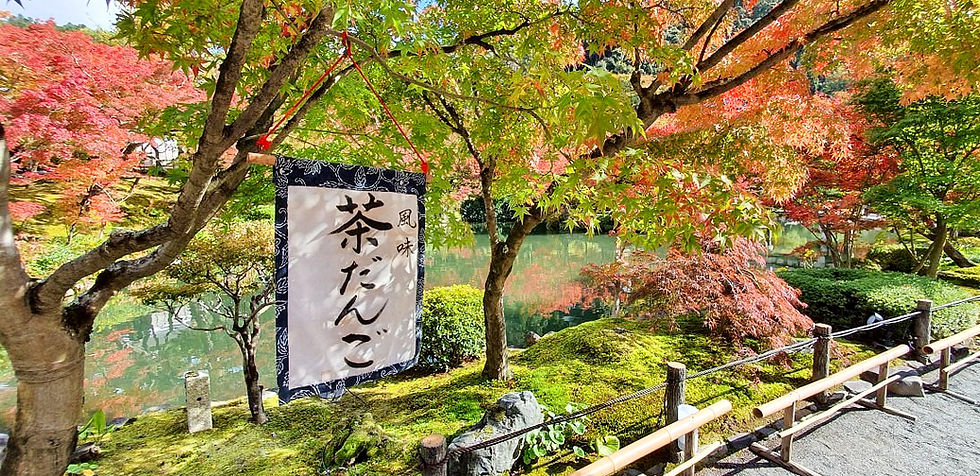Eikan-dō Zenrin-ji Temple
- Shannon
- Apr 28
- 4 min read
Updated: Jul 24
Kyoto’s Timeless Sanctuary of Beauty and Legend
Eikan-dō Temple, nestled at the foot of Mount Higashiyama in Kyoto, is renowned for its stunning autumn maple leaves and rich spiritual heritage. Founded in the 9th century amid imperial restrictions, the temple evolved from esoteric Shingon Buddhism to the more popular Pure Land sect under the guidance of its influential head priest. Ravaged during the decade-long Ōnin War, Eikan-dō lay in ruins for generations before being rebuilt in the 16th century. Today, it stands as a symbol of resilience, blending serene beauty with a turbulent history marked by war, transformation and haunting legends that continue to echo through its gardens.

Located at the northern foot of Mount Higashiyama, Eikan-dō stands as a testament to Kyoto’s layered history Eikan-dō, a sprawling complex that marries serene natural beauty with centuries of spiritual devotion. Though best celebrated today for its fiery autumn maples, the temple’s roots trace back to the 9th century when religious activity in Kyoto was still tightly controlled. The very establishment of Eikan-dō began under a shadow of prohibition, as constructing new temples was forbidden in the imperial capital. It was only after the intervention of Emperor Seiwa that the temple’s fate was secured, marking a rare moment where political will aligned with spiritual ambition.

Eikan-dō’s early years were marked by transformation and adaptability. Originally founded by a disciple of Kōbō Daishi, one of Japan’s most revered Buddhist masters, the temple began as a bastion of the esoteric Shingon sect. However, by the 12th century, under the guidance of the charismatic head priest Eikan, the temple embraced Pure Land Buddhism, reflecting a broader religious shift sweeping through Kyoto. This transition was more than theological, it signaled a move toward a faith that offered salvation and hope to common people amidst the often chaotic social landscape of medieval Japan.
The temple’s serenity was shattered in the mid 15th century during the Ōnin War, a devastating civil conflict that plunged Kyoto into near anarchy for a decade. This war, often seen as the catalyst for the prolonged Sengoku period of warring states, left Eikan-dō in ruins. The destruction was so complete that the temple lay abandoned for generations, a silent witness to the brutal fracturing of Kyoto’s political and social order. The sacred halls that once echoed with chants and scholarly debate were reduced to ash and memory, symbolising the fragility of culture amid warfare.

Reconstruction began slowly, fueled by the dedication of successive generations of priests who saw Eikan-dō not only as a place of worship but as a vital cultural anchor for Kyoto. By the 16th century, the temple had been lovingly rebuilt, blending traditional architectural styles with the emerging aesthetics of the Momoyama period. Yet, the scars of past conflicts lingered and local folklore began to weave dark threads into the temple’s story, tales of restless spirits and spectral monks said to wander the grounds, remnants of the souls lost in the city’s bloody upheavals.

One particularly haunting legend tells of a crimson clad spirit seen only during the height of autumn’s maple season. Said to be the restless apparition of a warrior monk who died defending the temple during the Ōnin War, this ghost is believed to curse those who disrespect the sacred grounds. Visitors and monks alike recount eerie sounds of chanting echoing through the gardens on moonless nights, a chilling reminder that beneath the temple’s beauty lies a turbulent past still whispering through its crimson leaves.

Today, Eikan-dō stands not just as a sanctuary of spiritual practice but as a living chronicle of Kyoto’s resilience. The temple’s gardens, carefully curated over centuries, symbolise renewal after destruction, while its halls preserve teachings that have evolved through Japan’s shifting religious landscape. For those who visit, the vibrant autumn leaves offer more than visual splendour, they are a vivid reminder of history’s cycles, where even in darkness and devastation, life, faith and beauty persist.

🗺️ Location
48 Eikando-cho, Sakyo-ku, Japan
🚆 How to get there
Eikan-dō Zenrin-ji Temple is conveniently accessible for visitors traveling from central Kyoto, though it requires a short walk from public transit options. The nearest subway station is Keage Station on the Tozai Line, which is about a 15 - 20 minute walk from the temple. From Kyoto Station, you can reach Keage Station in roughly 20 minutes, with a transfer at Karasuma-Oike Station, at a cost of around ¥260. For those who prefer bus travel, the Nanzenji-Eikando-michi bus stop is even closer, just a five-minute walk to the temple grounds. Kyoto City Bus number 5 connects Kyoto Station to this stop in approximately 35 minutes, with a fare of ¥230. Beyond its transit convenience, Eikando enjoys a prime location near the southern end of the renowned Philosopher’s Path, a scenic walking trail that follows a canal lined with hundreds of cherry trees, making it a perfect stop for visitors combining cultural exploration with nature strolls.
⭐ Attraction Info
As of 2025, this temple compound is open daily between 9am - 5pm, with last entry at 4pm. During the special Autumn illumination events, the temple offers extended evening hours from 5:30pm - 8:30pm. General admission during daytime autumn visits is ¥1200, while nighttime admission during these illumination events costs ¥700. For the remainder of the year, admission is ¥700 for adults and ¥450 for children. If you visit during the Autumn months, I HIGHLY recommend you time your visit with the night lights, it looks absolutely magical.
🔗 Official Website
Official Website : http://www.eikando.or.jp/English
永観堂禅林寺








